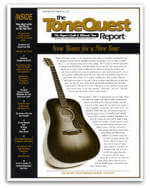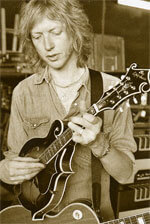
Following up on the successful introduction of 65 Amps’ flagship London 18W, the company has launched its second model — the Marquee. Named for the legendary Soho music venue where every ’60s British band of note once honed their craft, the Marquee is a bigger-sounding, louder version of the London 65 in some respects, endowed with great headroom and presence. We asked co-founder of 65 Amps and Sheryl Crow guitarist Peter Stroud to describe the musical intention of the Marquee, and our review follows….
TQR: What inspired the development and design of the Marquee, Peter? What did you want to accomplish specifically?
Peter Stroud: We had guitarists loving the sound of the London, but still needing either more volume or clean headroom. Personally, I wanted an amp to replace the Super Reverb in my live rig with that Fender clarity, but more of the openness and touch sensitivity of an amp like the London. Our initial idea with the Marquee was to create a more powerful version of the London 18 watter using 4 EL84s. But we also wanted something with the midrange clarity of the British amps and the clean sparkle of the American Fender Blackface sounds — just not as hard sounding as the 6L6 cleaner tone can be. On top of that, it has a higher gain tone that really roars.
TQR: To what extent were some of the design features in the Marquee such as the cascaded twin-triode operating in pentode mode and the 6-way Color control inspired by vintage amp designs?
 Peter Stroud: Our initial intention for the Cascode (note spelling) configuration in this amp was to find a sound similar to the pentode type EF86 tube we use in the London, but more quiet. Due to vibration and noise issues inherent with EF86 tubes, we were apprehensive using it in a higher powered combo. The cascode circuit, which utilizes a 12AX7, was popular in early hi-fi preamplifiers. It has a harmonic content similar to the pentode circuit but produces more even-order harmonics. Randall Aiken helped us greatly with this circuit and we’ve continuously tweaked it’s current configuration in our amp. The end result is a distinctly different sounding channel from the Treble-Mid-Bass channel — very warm and rich sounding. It sounds beautiful with single coils and 12-string electrics. So, the Marquee initially came from many inspirations. Dan (Boul) and I are big fans of the Selmer amps. A few years ago while on tour in the UK I had picked up a Selmer Treble & Bass 50 MkIII, which is the early ’70s silver metal front — the ugly one. But that amp sounds awesome, like a “British Fender Blackface” with two EL34s. We’ve since found a Mk I Treble ‘n Bass from the first year they were built.
Peter Stroud: Our initial intention for the Cascode (note spelling) configuration in this amp was to find a sound similar to the pentode type EF86 tube we use in the London, but more quiet. Due to vibration and noise issues inherent with EF86 tubes, we were apprehensive using it in a higher powered combo. The cascode circuit, which utilizes a 12AX7, was popular in early hi-fi preamplifiers. It has a harmonic content similar to the pentode circuit but produces more even-order harmonics. Randall Aiken helped us greatly with this circuit and we’ve continuously tweaked it’s current configuration in our amp. The end result is a distinctly different sounding channel from the Treble-Mid-Bass channel — very warm and rich sounding. It sounds beautiful with single coils and 12-string electrics. So, the Marquee initially came from many inspirations. Dan (Boul) and I are big fans of the Selmer amps. A few years ago while on tour in the UK I had picked up a Selmer Treble & Bass 50 MkIII, which is the early ’70s silver metal front — the ugly one. But that amp sounds awesome, like a “British Fender Blackface” with two EL34s. We’ve since found a Mk I Treble ‘n Bass from the first year they were built.
The font end of the Marquee Treble-Mid-Bass channel was initially inspired by the Selmer, but it branched off quite a bit. We just aimed for that sound. There are also similarities with the Selmer front-end circuit and the early ’60s brown-Tolex Fenders. I know one of your favorite amps is that killer Vibrolux 1×12 you have. The (Marquee) power stage is a fairly typical British-style 4-EL84 circuit. From there we spent months tweaking the tone circuit. We wanted the Treble-Mid-Bass tone configuration for more control with a higher powered amp.
TQR: You’ve played just about every conceivable guitar amp and for years your rig consisted of a Super Reverb and Marshall 50W. To what extent does the Marquee succeed in giving you both the clean and overdriven tones you need at usable state volumes, and how do you use it specifically?
Peter Stroud: On the latest tour I used both a London and a Marquee and A/B’d between the two. The two together worked perfectly for our stage volume. I’d set the London for a slightly driven rhythm sound playing through an EF86 channel and would use the gain boost for leads. The Marquee took the place of my Super Reverb as my clean sound, and it proved to be better since the mids are more pronounced and you get the nice dynamic saturation of EL84s. It’s much more touch sensitive, which is hard to get with a clean sound without using a compressor. The only time I’d kick on both amps was for Led Zep’s “Rock N Roll,” which we play as an encore. I’d crank the Marquee to 6, hit the gain boost and boost the mids. It totally hit the “Pagey” kind of sound. You can dump the mids and boost the bass and highs and get a chimey sparkling clean tone — settings around 4 on the volume, treble and bass around 6 to 7 and midrange around 4. For a cranking rhythm I’ll set the volume around6, boost the mids to 8 or so, drop the bass around 4, treble at 5. There’s also a footswitchable gain, like on the London, so you can set a rhythm tone on the T-M-B channel and kick in the boost for lead. If you turn the amp up to 10, look out!
TQR: You mention “mustard” caps on your web site being used throughout the amp — are these modern reproductions of the original “mustard” caps used by Marshall in the ’60s?
Peter Stroud: Yes, we use the SOZO caps made by John Gaynor. John’s a Marshall enthusiast who has totally nailed (and surpassed, in our opinion) the “mustard cap” tone where you get the nice smooth mids and bell-tone clarity.
TQR: What else are you working on?
Peter Stroud: We have two new models in the works — a smaller “grab n go” 1×12 combo which actually incorporates a master volume with two EL84s. It has a great sounding master volume that has a sound of its own that can be disengaged so that the amp ha a non-master function. Sort of a “British Fender” vibe again. The thing screams, it can get chimey clean, and it’s incredibly versatile. And over the past six months, we’ve been developing a KT77 head using our Marquee as the springboard with a KT77/EL34 power stage. We had a handful of pro level artists who wanted extreme volume and headroom, where they were used to their 50 and 100 watt EL34 hears and quite a lot of volume. Plus, Dan is a big fan of the Vox AC50 and I’m the Marshall fanatic, so we got into that mindset again. We sent a prototype out for a test run with Rich Robinson of The Black Crowes and he ended up using it as his main amp for the entire last month or so of their tour. When we got it back, all the knobs were dimed. Couldn’t ask for better testing in the field! We’ll introduce both of these amps at Winter NAMM.
REVIEW — 65 Marquee
 We spent a lot of quality time with the 35W Marquee Club, and it impressed us as a feisty chameleon that can gracefully move between big, jangly clean tones and an impressive roar with a deep palette of voices available from two very different input channels.
We spent a lot of quality time with the 35W Marquee Club, and it impressed us as a feisty chameleon that can gracefully move between big, jangly clean tones and an impressive roar with a deep palette of voices available from two very different input channels.
EL84 amps typically produce a distinct, musical compression characteristic that is absent in amplifiers using 6L6 output tubes, yet the Marquee produces gobs of clean headroom — albeit British headroom rather than the trademark 6L6-fueled fidelity of a Fender amp like the Twin or Super Reverb. As far as we’re concerned, British tone in an amplifier denotes rich harmonic depth and chime, often augmented with a dominant midrange emphasis, while Fender amps (Blackface models in particular, sound scooped in the mids by comparison with a wider, broader, looser feel and toner not unlike the difference between the sound of oooh and ahhh. In the Marquee, individual strings seem “closer together,” yet still well-defined throughout its range of clean settings. EQ coloration is accomplished in the “Classic” Channel bass/mid/treble/cut controls, and in the “Normal Channel via six EQ presets on a rotary switch. This “color switch” progressively thickens tone with gradual increases in lows and mids, but the Marquee’s chime and sparkle remain audibly preserved in every setting.
The Marquee produces moderate levels of smooth, overdriven tone at higher volume settings (+6) in the Normal Channel that can be neatly managed from the volume on your guitar, while the footswitchable Boost feature in the Classic Channel yields scorching distortion and sustain that nearly rival that of a Marshall JCM 900 Series Mk III. However, the Marquee delivers a chimier crunch rather than the more linear and cutting, laser beam focus of a high-gain Marshall. It’s a prettier brand of mayhem, if you will. And unlike many vintage British amps, the Marquee succeeds in delivery an enhanced range of both clean and overdriven tones, as well as a more versatile and varied range of EQ emphasis. Overall, we found it to be an inherently bright amp with the EQ controls in neutral settings, but you are also given plenty of room to shape the voice of the Marquee, from brilliant and clangy, to thick, heavy and imposing. We had no trouble dialing in great tones with all of our guitars — thickening the Teles and Stratocasters, planting a wet kiss of treble emphasis on the humbucking Gibsons, and alternatively mining the jangly clean chime and perfect meltdown of P90s. A potent rock amp that can cover a lot of ground, the Marquee is handwired with point-to-point construction that meets the high standards we have all come to expect from custom builders today, the transformers are custom-made by Mercury Magnetics, and the fit and finish of the cabinet work were flawless. As the name implies, the Marquee is steeped in the tones that defined modern rock & roll, viewed through a properly British perspective. And as Fender’s Ritchie Fliegler is fond of saying, “If this is what you like, you’ll really love this!” Quest forth, mate.
Source: https://mercurymagnetics.com/pages/news/ToneQuest/_2007/TQRJan07-2.htm